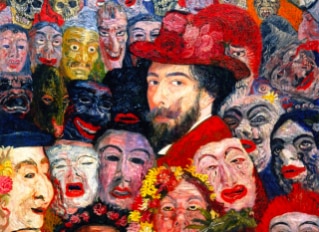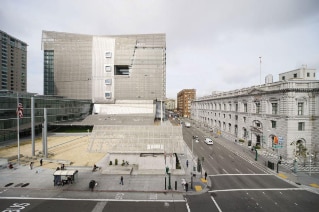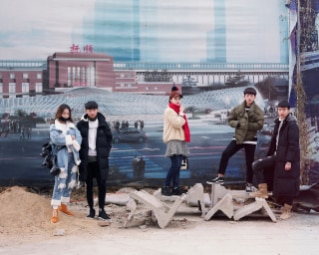While the city has been both the site and subject of these demonstrations, I would like to argue that the built environment itself can actively function as the agent of its own revolution. Rather than the form of occupations that have been most recently displayed in the United States and present an easy target for repression by a classical police force, I would like to explore the potential of more diffuse, subversive means that escape traditional means of control.
The synthesis of art and public space is unique for its potential to act as a passive form of resistance by representing the development of conflict within the territory it contests. To illustrate my thesis I will explore a city whose protests have gone under-reported compared to other global occurrences: Santiago, Chile. Like many cities, Santiago's street art is a result of its specific history and the political actuality. It is an obvious signifier of the political and historical development of Chile, of which the ongoing contemporary manifestations represent a new stage of social engagement within a long series of such events.
In 1970, Chile became the first country in the world to democratically elect a Marxist president, Salvador Allende. His policies to nationalize education, industry, health care, land distribution, business, and other basic elements of social development aimed to neutralize the underlying class structures of inequality that were established by the Spanish colonization and continued into the 20th century with successive oligarchies of the Chilean ruling class.
Three years later in 1973, with the military coup d'état led by Augusto Pinochet, Allende's legacy was overturned by the following 17 years of military rule that would revoke virtually all public welfare policies and fundamentally shape the contemporary context of Chile. Precipitated by repressive social force, the socialist policies were replaced with the transplantation of the explicitly neoliberal economic ideology from the Unites States into Chile by utilizing the methodology didactically outlined in the University of Chicago's "Chile Project". Although its end result has recently been extremely profitable in strictly financial terms, the period of Chilean history between 1973 and 1990 was marked by violence, initiated by a mass execution of known socialists in the public football stadium where matches are still played today. With the concurrent principles of deregulation, privatization, and globalization of local industry, Chile is currently home to the strongest performing economy of Latin America alongside the highest degree of economic inequality among its citizens.
When in 1990 Pinochet gave the government over to a democratically elected president as a result of a plebiscite in 1988 [2], the neoliberal policies were just beginning to economically bear out. While the new government granted a great deal of social liberties, its economic framework stayed fastidiously in place with subsequent legislative reinforcements. While Pinochet's rule ended, his specifically economic policies grew to new extremes [3]. Freedom of expression, previously outlawed in the continual persecution of internal resistance to the fascist government, has over the past twenty years engendered an intense culture of street art. Within this historical context, the art presents a subjective presence through the employment of an urban agency that was formerly repressed. Viewed as a collective body, the art establishes a public that was repressed under the rule of Pinochet. It is through these means of subversive representation that public art is imbued with a unique opportunity for political efficacy.
The street art in Santiago [4] primarily consists of fantastical pictographic styles depicting human faces and bodies, animals, and other creatures in typically bright colors that stand in contrast to the rest of the built environment. Most prevalent in lower-class neighborhoods that were rapidly developed in a process of modern urbanization, the art is not explicitly vocal of any political or otherwise ideological agenda, such as the street art in Bolivia that speaks of the fading of traditional society, or in Argentina that speaks directly to its history of fascism. What I will henceforth argue is that the agency of Chilean street art is its own sheer presence. It is not the content of the pieces themselves that contain a revolutionary potential, but within their nature as empty signifiers that create an immanent experience of the everyday environment. Standing as symbols that have no meaning, we inscribe ourselves into this void as the art creates a habitat for collective memory. The passive experience of the built environment is transformed into the active theatre of inhabitation [5].
Juxtaposing a creative act on top of the build environment invests the art with a radical contextuality where the artist not only responds to the mere physical attributes that make their canvas, but reacts to the conditions which gave form to the city and its contemporary perception. In Santiago, the city stands as the charged object bearing memory to its ideological history, reifying the class disparity in the long blank walls of poorer neighborhoods compared to ornate singular architectural objects of wealth. The presence of street art in Santiago subverts the aesthetic and cultural framework of the city and literally provides an alternate way to perceive the context. While the art works at a superficial level and does not fundamentally alter the reifying structures that generate the sociopolitical situation itself, its near-subliminal nature as an everyday artistic presence has a strong capacity to augment the imaginative capacity by which people live in and develop the future of their city [6].
While it is impossible to judge at this time as to the ultimate political and revolutionary potentialities of street art, a more detailed look at the recent contemporary events in Chile could reveal further insight into the matter. In the past decade there have been major reforms addressing extreme poverty with a wide-scale public housing program that seeks to elevate the lower class and provide them with basic tools for advancing into the full market economy with a means to obtain capital through growth-based real estate [7]. Alongside these social policy changes was the development of the higher education sector that moved towards policies of high tuition and profiteering off those aspiring to advance themselves through its institution. These two concurrent developments are not only contradictory, but the latter effectively negates the efficacy of the former as the economic bar is raised all around.
For the past six months, Santiago as well as other Chilean cities have been vocalizing a dissensus with the government of Sebastián Piñera. Through a succession of demonstrations and strikes primarily focusing on systemic educational reform, the result has often solely been violence [8]. With actions having spread beyond just students to unions and workers, the situation has escalated to include multiple city-wide strikes that cripple its most basic functions and increasing unrest [9]. In a moment where seemingly one country after the other is starting to express its discontent in more destructive terms, perhaps it is time to question the limits and potentials of public art as a means towards achieving what is sought. Despite concessions by the government, talks between the students and the government have failed as a consensus seems to be unreachable by either party at this time [10]. Facing these radical ideological differences between co-habitants of a single city and country, street art allows us to resituate our perceptual framework in a more localized context, within which we may be able to effectuate change, ourselves, right now.
NOTES
[1] http://edition.cnn.com/2011/11/21/world/africa/egypt-protests/
[2] http://es.wikipedia.org/wiki/Plebiscito_nacional_de_1988_(Chile)
[3] http://davidharvey.org/2011/11/videodavid-harvey-at-occupy-london-november-12-2011/
[4] http://nickaxel.net/index.php?/project/the-involuntary-museum/
[5] Ranciere, Jacques. "The Emancipated Spectator." The Emancipated Spectator. Trans. Gregory Elliott. London: Verso, 2009
[6] http://www.domusweb.it/en/op-ed/back-to-the-streets-the-rise-of-performance-architecture/
[7] http://www.elementalchile.cl/viviendas/quinta-monroy/quinta-monroy/
[8] http://www.nytimes.com/2011/08/10/world/americas/10briefs-Santiago.html
[9] http://www.bbc.co.uk/news/world-latin-america-14660857
[10] http://www.aljazeera.com/news/americas/2011/10/2011106181758485239.html
Nick Axel is currently keeping himself occupied in Madrid, Spain, continuing his engagement with the discipline of architecture through a variety of mediums in order to reveal latent opportunities for spatial praxis in the contemporary city.







